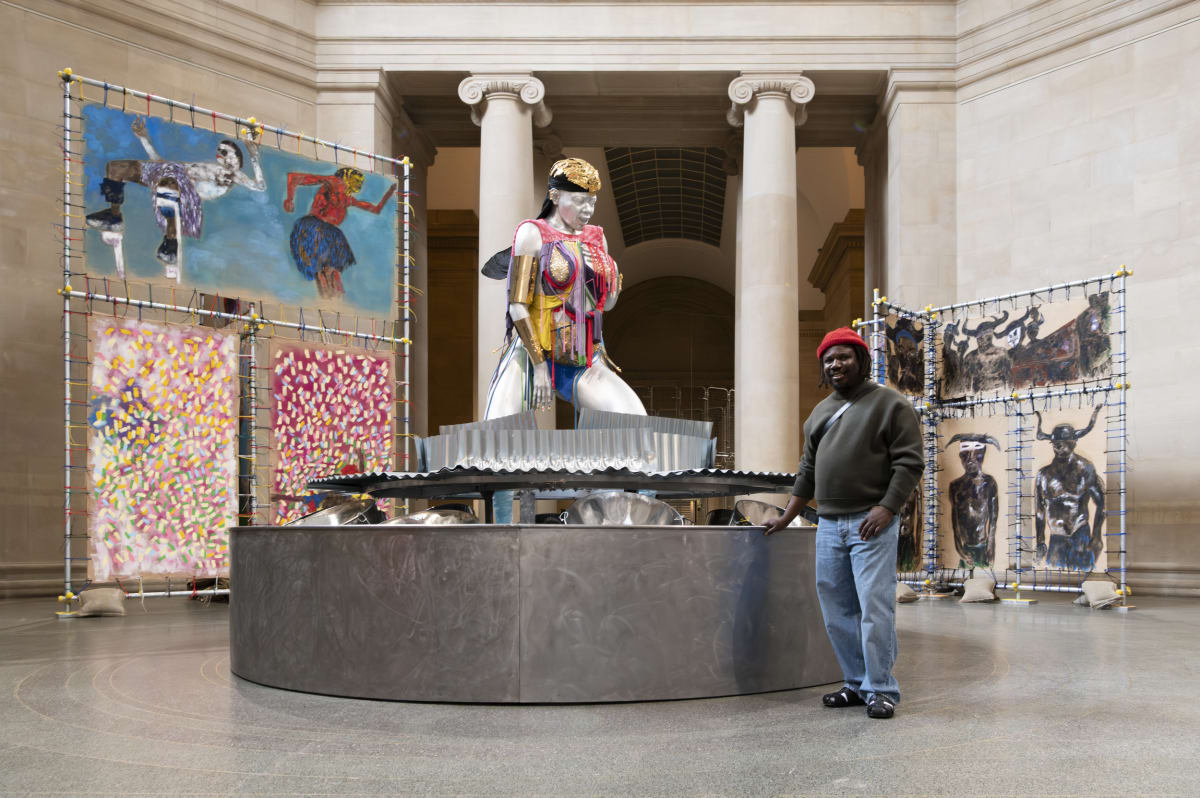Alvaro Barrington: Grace review Church pews, chains and a carnival queen
By Adrian Searle
From a sticky Caribbean thunderstorm to the cocaine-fuelled violence of the New York street corner, the artist takes us through the highs and lows of his journey to the present moment
A soundtrack of rain sizzles on a tin roof, interspersed with snatches of music and radio voices struggling against the storm. The shiny tin slung overhead and the bare neoclassical walls compound the echoing reverb of the Duveen Galleries at Tate Britain. I want to sink to one of the rattan sofas grouped about the floor, close my eyes and drift to the noise of the sweltering hurricane season in the Caribbean. It’s enervating. I think of sweat glueing my body to the protective clear plastic cover of the sofa. Maybe they should turn the heating up, to complete the experience.
This is the opening that greets visitors to Alvaro Barrington’s Grace, his three-part Tate Britain commission. The length of the Duveen and its division into three sections invites a narrative approach, a journey in time as well as space. For now, we are in Grenada, in a kind of symbolic, schematic recreation of Barrington’s childhood home, living with his grandmother.
At the rear of this first space, two L-shaped sections of white-painted wall, like the corners of a room, create a division. Glazed windows are closed against the imaginary weather. The details start to snag you: the woven abstract curtains, the embroidery decorating the old postcards trapped under the plastic sofa covers, along with numbers of drawings, but they’re hard to see properly. Maybe knowing they are there is enough, reminders of childhood activity on days when you can’t play outdoors. All these works are by one of Barrington’s collaborators, Teresa Farrell.
The central rotunda space in the Duveen recreates the atmosphere of carnival, with numerous paintings by Barrington stretched with twine between tall scaffoldings of metal bars, around the edges of the space. Loosely painted figures and faces – bird-men and bodies drenched in blue pigment, masked carnival figures in fanciful costumes, a figure that reminds me of one of Goya’s folkloric buffoons, loom from unprimed burlap canvases. Among this motley parade are a few abstract tachiste manoeuvres. Like carnival itself, everything feels loose and improvised and assured, a clamour of touches, moods and modes.
[...]
Barrington’s wall texts are a model. They don’t tell you what to think or feel. They’re pointers, detailing his own story and indicating how Grace came about. Right at the end, we come to three rows of church pews. Sitting there, and looking back beyond the cell, the pleasures of carnival and the distant sounds of childhood are framed by the Duveen’s columns. Up above them is a stained-glass window he has made to fit the final archway high up towards the roof. Church was a bulwark against all the violence on the street, the randomness and isolation. It meant community, and some sort of hope of grace. Hence the title.
Barrington’s commission evokes his origins and his journey to be here now. It is full of life. For descendants of slavery, people to whom the apocalypse had already happened generations ago, the occupation of an institution built on the proceeds of the Tate sugar trade and colonialism, Barrington’s Grace has a particular resonance. I think Barrington wants to turn the Duveen into a lively, open experience, and one that acknowledges the space it occupies.














































































































































































